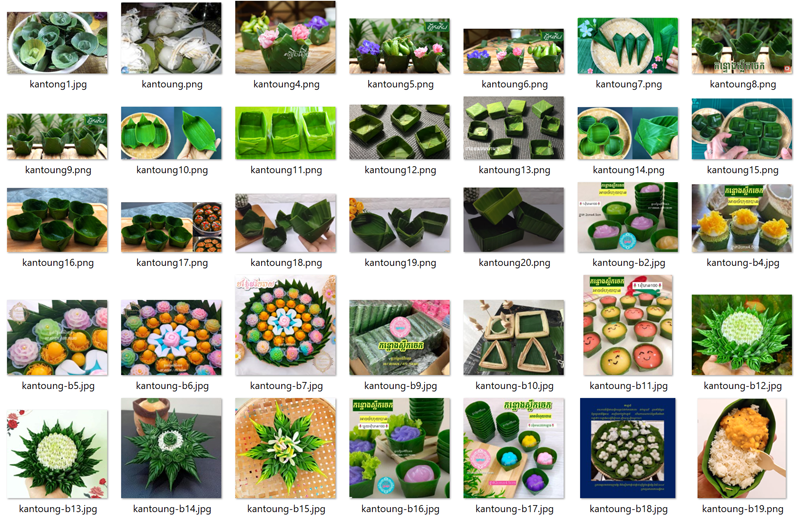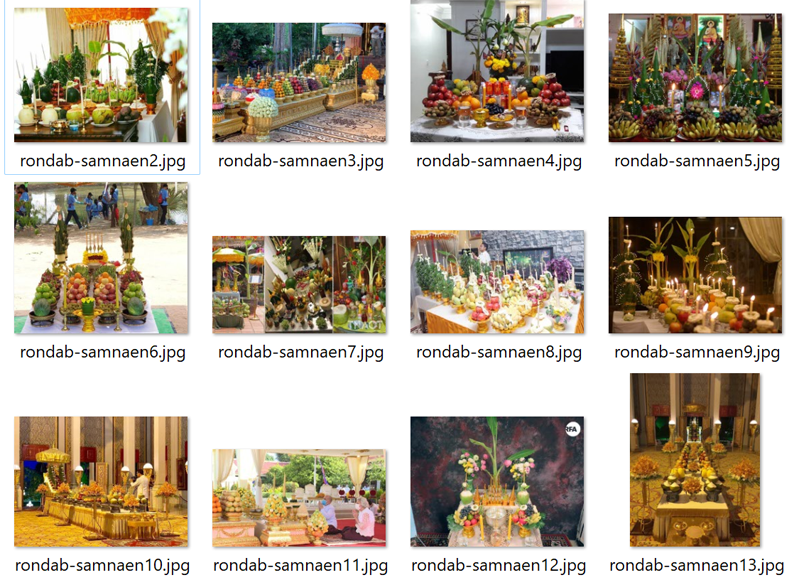Some major Khmer's archelogy site, art: Banteay Top | Banteay Mean Chey | Prasat Khna | Sambo-gupta's art, jawelry1, 2lintel, 3army-assur, 4palace, 5Visnu | Khmer's charpant ancient and modern, Khmer's treiphum 19th, Khmer's coin, Funan/Chenal, Khmer's coin, sneng 15th-20th, tai's coin, duong, Khmer's art and culturev : Baysei | Brotib | Kaum | Kantoung | Rondab | Rondab Samaen | |
១/បាយសីក្នុងប្រពៃណីខ្មែរ បាយសី ឬ បាយសី្រ ឬ បាយសិរិ គឺជាតង្វាយដ៏ពិសិដ្ឋក្នុងប្រពៃណីរបស់ខ្មែរ សម្រាប់ឧទ្ធិសដល់ទេវៈ និងដល់វិញ្ញាណបរិសុទ្ធនៃធម្មជាតិ ឬព្រៃឈើជាដើម។ បាយសីប្រពៃណីខ្មែរត្រូវធ្វើពីដើមចេក ស្លឹកចេក និងផ្កាផ្សេងៗដែលអ្នកបង្កើតអាចផ្សំតាមគំនិតច្នៃប្រឌិត និងការស្រមៃរបស់ខ្លួន។ វាជាទម្រង់នៃ សិល្បៈ និងស្ថាបត្យកម្មដ៏ពិសិដ្ឋ និងស្មុគ្រស្មាញរបស់ខ្មែរ ដែលត្រូវបានខ្មែរបញ្ចូលក្នុងទម្រង់ជាច្រើន និងផ្សេងៗគ្នា សម្រាប់ការកសាងប្រាសាទ កសាងសិល្បៈ វប្បធម៌ និង ការសាងសង់វត្តអារាមរាប់ពាន់របស់ខ្មែរ។ ការពិតទៅ វាជាការចរនាវិសាលភាពនៃ ទម្រង់ OM ពិសិដ្ឋរបស់ខ្មែរក្នុងទម្រង់ចម្រុះ និងផ្សេងៗគ្នា។ ទម្រង់នៃ Bansei ត្រូវចរនាជាជាន់ថ្នាក់ច្រើន។ ទម្រង់ពិសិដ្ឋនេះ ក៏មាននៅក្នុងភាសា និងអក្សរសាស្ត្រខ្មែរដែរ។ អ្នកចរនាបាយសីអាចបង្កើតបាយសីតាមក្តីស្រមើស្រមៃ និងគមនិតឆ្នៃប្រឌិតរបស់ពួកគេ តែត្រូវគោរពយ៉ាងម៉ឺងម៉ាត់នូវក្រិតក្រមក្បួនច្បាប់រណាប់បាយសីរបស់ខ្មែរ។ ថ្វីបើខាងព្រះពុទ្ធសាសនាហិនយាន បានអះអាងថា បាយសីជាផ្នែកមួយនៃព្រះពុទ្ធសាសនាហិនយាន ប៉ុន្តែប្រពៃណីឯកវចនៈ បែបនេះមានតែនៅកម្ពុជាតែប៉ុណ្ណោះ មិនមាននៅក្នុងសាសនាហីនយានក្នុងប្រទេស ដ៏ទៃទៀតក្រៅពីកម្ពុជា។ គួររំលឹកថា ប្រពៃណីនេះគឺជាមរតកនៃព្រហ្មញ្ញសាសនារបស់ខ្មែរ មុនពេលដែលប្រទេសកម្ពុជាទទួលឥទ្ធិពលពីពុទ្ធសាសនាហីនយាន ចាប់ពីថ្ងៃ ១៥ មក។ អ្វីដែលត្រូវកត់ចំណាមួយទៀតគឺ បាយសីខ្មែរ ត្រូវតែធ្វើឡើងតែពីស្លឹកចេក ធាងចេក ដើមចេក និងផ្កាភ្ញីប៉ុណ្ណោះ មិនមានដាក់ម្ហូបចំណី ត្រីសាច់អ្វីលាយលំលើឬជាមួយបាយសីនោះទេ តែក្នុងរណ្តាប់សំណែន ផ្សេងៗ បាយសី និងចំណីអាហារត្រូវបានទេ ដាក់រៀបតាំងតម្រៀបក្បែរៗគ្នា តែនៅតែ ដាច់ដោយលែកពីគ្នាដដែល។ នៅសម័យអង្គរ ប្រាសាទបន្ទាយស្រី ឬបន្ទាយសិរិ ជាកន្លែងពិសិដ្ឋដែលបុព្វបុរសដ៏អស្ចារ្យរបស់ខ្មែររក្សាជាកន្លែងរណ្តាប់បាយសី ថ្វាយអទិទេព។ តាមទំនៀមបុរាណរបស់ខ្មែរ តង្វាយប្រភេទនេះ ត្រូវបានរៀបចំសម្រាប់ឧទ្ទិសដល់ព្រះសិវៈ ជាព្រះនៃព្រះ ជាអ្នកបង្កើតនូវសារពើវត្ថុក្នុងចក្រវាឡ៏ និង និងពហុចក្រវាឡ៏។ ជាអ្នកបង្កើត ទាំងរបស់មានជីវិត និងគ្មានជីវិត ទាំងជីវិតដែលអាចមើលឃើញ បះពាល់បាន និងមើលមិនឃើញ ជាអ្នកបង្កើតពន្លឺ និងភាពងងឹត ពីកំទេចពន្លឺ ប៉ាទីគុល ទៅពហុចក្រវាឡ៏។ ដូនតាខ្មែរតែងគោរពប្រតិបត្តិកោតខ្លាចដល់ទ្រង់លើសអ្វីៗទាំងអស់ និងបានថ្វាយនូវ ព្រះតេជៈគុណូបក្ការៈ ដ៏ខ្ពង់ខ្ពស់បំផុតដល់ទ្រង់ ជាព្រះនៃអចិន្ទ្រញាណ អចិន្ទ្រវត្តមាន និងអតិអចិន្ទ្រនុភាព។ បាយសីរបស់ខ្មែរតំណាងឱ្យពហុភក្រ និងពហុវិមាត្ររបស់ទ្រង។ ទាំងនេះ ត្រូវបានខ្មែរ ចរនាក្នុងទម្រង់ចម្រុះផ្សេងៗក្នុងវប្បធម៌ អក្សរសាស្រ្ត និងសិល្បៈខ្មែរ និងសម្រាប់ការប្រឌិតសាងវត្តអារាម និងប្រាសាទនានា របស់ខ្មែរ ជាពិសេស ក្នុងសិល្បៈ និងការកសាងបរមវិស្ណុលោក ឬអង្គរ និងបន្ទាយសិរិជាដើម ។ល។ Khmer’s Baysei in Khmer's culture Baysei or Bay Sirei or Bay Sri is the Khmer's traditional sacred offering for divert divinities and to the holy spirit of nature or forest ect. Khmer's traditional Baysei must made of Banana trunk, Banna’s leave and divert various flowers to which the creator can composed according to their creativities and imagination. It's a form of Khmer’s sacred and complex architecture which took in various and multiform among thousands of Khmer’s temple and pagodas. It’s first of all the form of Khmer’s sacred OM in multiple and various form and its extent. The form of the Bansei must compose of multiple level. The creators of Baysei can compose Baysei according to their imagination by strickly respecting the Khmer’s sacred code of Baysei. Even Hinayana Buddhism claimed as a part of Hinayana Buddhism but this kind of singular tradition exist only in Cambodia. It’s to remind, this tradition is the heritage of Khmer's Hinduism well before Cambodia being influenced by Hinayana Buddhism from 15th. |
 |
២/ប្រទីប/Brotib, in Khmer's culture អ្វីទៅប្រទីប ក្នុងប្រពៃណីខ្មែរ? តាមការអោយនិយមន័យព្រាលៗ តាមវចនានុក្រមនានា ប្រទីបសំដៅ រណ្តាប់ដែលមាន គោម ឬចង្កៀង ភ្លើងបំភ្លឺ។ តែជាក់ស្តែង ក្នុងប្រពៃណីខ្មែរបុរាណ ប្រទីបសំដៅប្រដាប់សំណែន រចនាពីស្លឹកចេក ស្រទបចេក លំអរដោយផ្កាភ្ញីផ្សេងៗ ដែលគេរចនាជារាងមូល ទ្រវែង ឬបួនជ្រុង។ល។ និងមានដាក់ទានឬចង្រៀង ចំកណ្តាល់សម្រាប់អុជបំភ្លឹពេលគេយក ទៅបណ្តែតតាមទឹក។ ក្នុងប្រពៃណីខ្មែរ ប្រទីបដែលមានអុជភ្លើងបំភ្លឹខ្មែរប្រើសម្រាប់តែបណ្តែតតាមទឹក។ ប្រពៃណី នេះមានប្រវត្តិទាក់ទងនឹងព្រហ្មញ្ញសាសនារបស់ខ្មែរ បា្ររព្ធបូជចំពោះព្រះម៉ែគង្គា ឬព្រះនាងគង្ហីង តែក្រោយមក ពេលខ្មែរបែរមកកាន់សាសនាហីនយាន គេបានបង្វែរវិធិនេះ ជាវិធីជូនដូនតាទៅផ្ទះក្រោយវិធីបុណ្យភ្ជុំបិណ្ឌ។ ខ្មែរតែងចាត់ទុកបឹងបួរធំៗ ជាពិសេសបឹងទន្លេសាប និងមេគង្គ ជាមហាទន្លេគង្គា។ សម័យបច្ចុប្បន្ន គេឃើញមានការរចនាទូកប្រទីបជា លក្ខណៈរដ្ឋបាលនិងក្រសួងនានា ដែលគេយកទៅបណ្តែតទឹក។ ការពិតប្រពៃណីនេះ ហាក់មានតាំងពីសម័យមុនអង្គរ និងសម័យអង្គរ ដូចដែលបានបន្សល់ជាភស្តុតាង លើត្រៃបាត នៃព្រះសិវិៈ និងព្រះវិស្ណុ។ By definition, according to various dictionaries, Brotib refers to the lanterns or lamps. But in the ancient Khmer tradition, Brotib refers to a basket of offerings made from banana leaves, banana peels, decorated with various flowers with a set of light in the middle. The se of light will be turn up while letting floating/Bandaet. Basket of Brotib can be made in different shape, round, triangular or square, etc. Normally, this kind of sacred offering basket is the bas of all sacred offering in Khmer’s culture called Rodab Samnaen but while it's composed with the set of light in the middle and let floating on the water, it become Brotib. In Khmer’s ancient culture, Bandaet Brotib ceremony is dedicated for the Goddess of water, the Ganga but while Cambodia was converted to Hinayana Buddhism, they turned it into another myth related to Hinayana Buddhism instead. |
 |
| ៣/គោម/Kaum គោម គឺជាចង្រ្គៀង រចនាផ្កាភ្លី ឬជាចង្គ្រៀងធម្មតាៗ សម្រាប់បង្ហោះក្នុងអាកាស និងអុជព្យួរនៅមុខផ្ទះ ឬ ក្នុងផ្ទះ ឬតាមទីសាធារណៈ។ ក្នុងន័យមួយទៀតក្នុងអក្សរសាស្ត្រខ្មែរ គោមសំដៅ ការចងរចនាផ្កាភ្ញី ឬប្រដាប់ផ្សេងៗ ចេញជាកញ្ចុំ ឬជាកន្សោមលើផ្ទាំងក្រណាត់ ឬទម្ររអ្វីមួយ ឧ៖ គោមហូលផាមួង។ល។ In Khmer's culture Kaum, it refers to the flaying or suspending lanterns. The lantern that flying on the sky is a Kaum. A Chandelier is a Kaum. The sleeve lantern is a Kaum. It’s to say, all the flaying or suspending lanterns are all Kaum. Another definition in Khmer's literature and culture, Kaum also refers to the ensemble of designs or composition combine together to produce a specific band of design expressive on the Khmer's traditional silk tissue ex Kaum Hold or Phamoung ect |
 |
៤/កន្ទោង/Kantung in Khmer's culture កន្ទោងផ្កាភ្ញីទាំងនេះ បើមិនមានចង្រៀងគោម ឬទានអុជបំភ្លឺ ហៅថា សណ្តាប់សំណែន តែពេលដែលដាក់គោម ភ្លើងនៅកណ្តាលបំភ្លឺបន្ថែម វាបានក្លាយជា ប្រទីប។ ប្រពៃណីខ្មែរមួយនេះ ត្រូវបានពួកជនជាតិសៀមចម្លងយកទៅ តែដោយជនជាតិសៀមមិនយល់ខ្លឹមសារ និងអត្ថន័យ នៃវប្បធម៌ពិសិដ្ឋរបស់ខ្មែរមួយនេះ ជនជាតិសៀមបានហៅវិធីបណ្តែតប្រទិប របស់ខ្មែរថា លយកន្ទោង។ ធម្មតា លយ ជាពាក្យមួយទៀតរបស់ខ្មែរ មានន័យស្រដៀងនឹងបណ្តែតដែរ តែជាពាក្យសមញ្ញ ឬសម្រាប់ប្រើក្នុងកាលៈទេសៈផ្សេងពីវិធីពិសិដ្ឋនេះ។ ឯពាក្យកន្ទោងក៏ដូចគ្នា។ ក្នុងន័យខ្មែរសមញ្ញ កន្ទោង គ្រាន់តែជាការកាច់ស្លឹកឈើ ឬក្រដាស់ផ្សេងៗធ្វើជាថ្នក់ គ្រលុក ជ្រុង មូល ទ្រវែល។ល។ សម្រាប់ដាក់របស់ ចំណីផ្សេងៗ តែដោយជនជាតិថៃ មិនយល់ ហើយចេះតែចម្លងរបស់ខ្មែរទាំងងងឹតងងុល យកទៅប្រើផ្តេសផ្តាស់ទូទាំងនគររហូតដល់សព្វថ្ងៃតែម្តង។ In Khmer’s language and culture, Kantoung refers to the containers or box or basket made of vegetal leaf in particularly of banana leaf or peel. Khmer used Kantoung or vegetal basket/box as containers or recipient for different usages: to containers ordinary foods as well offering foods, salty or sweet. In Khmer’s culture some particularly food like Haramok/Amok, Nom Plae aiy as some other caked or foods are confined in the Kantoung(vegetal basket) etc It’s to say, Kantoung or vegetal basket is very famous in Khmer’s culture. There’re so many different styles of Kantoung made of various vegetable leaf as simple daily recipients or more luxurious decorated while it is made for sacred or religious ceremony. This Khmer’s sacred culture is carved on the temples of Bayon, Banteay Chhmar and other Khmer’s sacred temples in Cambodia as well in Thailand, Laos and Vietnam. On the walls of Bayon, we can admire the Queens and Princesses of Khmer’s Empire, offered the luxurious decorated Kantoung to the spirit of sacred three called three of Arok-Arak or three of life. On the wall of Banteay the luxurious decorated Kantoung become Brotib offered to the Mother of Ganga/Prah M e Kongkir. This sacred Khmer tradition was copied by the thais but as thais are just copycats and know so little about Khmer’s sacred culture, they call this Khmer’s sacred culture as loy Kantoug which mean in Khmer basic ordinary language as floating the basked vegetable while Khmer used a noble language for this sacred ceremony. |
 |
| ៥/រណ្តាប់សំណែន rondab danvay/rondab Samnaen/Chumnoun in Khmer's culture រណ្តាប់សំដៅវត្ថុព្រៀងតាមក្បួនរណ្តាប់ សម្រាប់ធ្វើទាន ធ្វើអំណោយ ឬសម្រាប់ទទួលភ្ញៀវ ឧ៖ គ្រឿងទេយ្យទាន, ទ្រនឹបគ្រូ, គ្រឿងបណ្ណាការ, (រៀបរណ្តាប់គ្រូ, រៀបរណ្តាប់ការ, រៀបរណ្តាប់ទេយ្យ។ល។) រណ្តាប់មានច្រើនបែបយ៉ាង ទៅតាមវិធីនិមួយៗ។ ការរចនារណ្តាប់ ក៏មានច្រើនសណ្តាន និងមានលក្ខណៈខុសៗគ្នាតាមវិធីនិមួយៗដែរ។ នៅក្នុងរណ្តាប់សំណែន អាចមានបាយសីច្រើនបែបសណ្តាន។ ឯជាជំនូន ឬសំណែន អាចមាន ជាបន្លែផ្លែឈើ ត្រីសាច់ ច្រើនបែប។ ក្នុងវិធីខ្លះ គេដាក់សំណែនក្នុងកន្ទោង ធ្វើពីស្លឹកឈើផ្សេងៗ ជាលក្ខណៈសមញ្ញ ឬប្រណិតលំអរដោយផ្កាភ្ញី ។ល។ Rondab danvay, Rondab Samnaen or Rondab Chumnoun refers to the sets of gifts or the sets of offerings preparing for special occasion for spirituel as well for religious ceremony or ritual according to the strict rules recommended by the guru. It can be the offering for the divinities, for the spirit of nature or the spirit of ancestors as well for ordinary people these included for some particularly gurus. The bride dowry offered by the family of the groom is also considered rondab ( rondab kar), rondab krou(offering for the guru or teacher ect) In Khmer's culture, there are so many types of Rondab: rondab danvay, rondab samnaen, rondab chumnoun. Each set of offering is prepared differently according the type of ceremony and people to which rondab is designed for. Below pictures are few examples of Rondab in Khmer's culture. |
 |
Update Décembre 2023 |
| បណ្ណាល័យព្រលឹងខ្មែរ- 7 | 6 | 5 | 4 | 3 | 2 | 1 | ~ *~ 1 | 2 | 3 | 4 | 5 | 6 | 7 - បណ្ណាល័យព្រលឹងខ្មែរ |